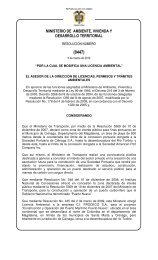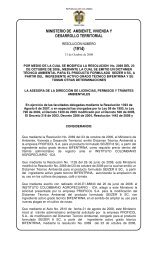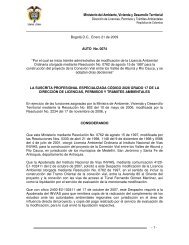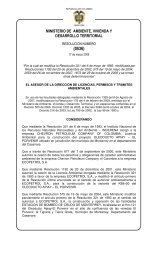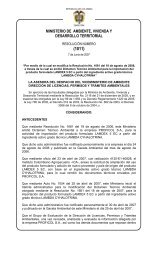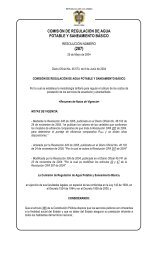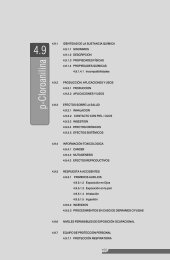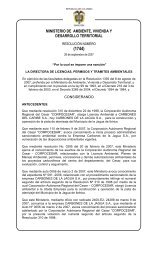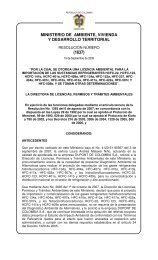guia ambiental para la construccion o ampliacion de pistas ...
guia ambiental para la construccion o ampliacion de pistas ...
guia ambiental para la construccion o ampliacion de pistas ...
You also want an ePaper? Increase the reach of your titles
YUMPU automatically turns print PDFs into web optimized ePapers that Google loves.
VERSIÓN 0.1<br />
Abril <strong>de</strong> 2001<br />
8.9 ZONAS DE DISPOSICIÓN DE MATERIALES<br />
SOBRANTES DE EXCAVACION PAG. 76<br />
CAPIS 8-09<br />
1. OBJETIVO<br />
Disponer el material sobrante <strong>de</strong> excavación generado durante<br />
<strong>la</strong>s activida<strong>de</strong>s constructivas, bajo condiciones que reduzcan<br />
el impacto <strong>ambiental</strong>.<br />
2. IMPACTOS AMBIENTALES A MANEJAR<br />
‣ Emisión <strong>de</strong> material particu<strong>la</strong>do.<br />
‣ Aporte <strong>de</strong> sedimentos a cuerpos <strong>de</strong> agua.<br />
‣ Destrucción y afectación <strong>de</strong> vegetación.<br />
‣ Fenómenos <strong>de</strong> inestabilidad y remoción en masa.<br />
‣ Generación <strong>de</strong> procesos erosivos.<br />
‣ Afectación <strong>de</strong> predios.<br />
‣ Alteración <strong>de</strong>l paisaje<br />
3. TIPO DE MEDIDAS<br />
‣ Prevención<br />
‣ Control<br />
‣ Mitigación<br />
4. CRITERIOS DE MANEJO AMBIENTAL<br />
La pre<strong>para</strong>ción y operación <strong>de</strong> los ZODMEs pue<strong>de</strong> incluir <strong>la</strong>s<br />
siguientes activida<strong>de</strong>s:<br />
‣ Descapotar previamente en un espesor mínimo <strong>de</strong> 0.20 a<br />
0.50 m <strong>para</strong> retirar <strong>la</strong> capa vegetal. Los materiales <strong>de</strong><br />
<strong>de</strong>scapote se acordonarán en el bor<strong>de</strong> <strong>de</strong> <strong>la</strong> zona <strong>de</strong><br />
bota<strong>de</strong>ro.<br />
‣ Excavación <strong>de</strong> zanjas o asequias <strong>de</strong> <strong>de</strong>sviación <strong>de</strong><br />
corrientes <strong>de</strong> agua que se encuentren <strong>de</strong>ntro <strong>de</strong> <strong>la</strong> zona y<br />
construcción <strong>de</strong> obras <strong>para</strong> manejo <strong>de</strong> drenajes<br />
‣ Construcción <strong>de</strong> enrocados disipadores <strong>de</strong> energía en <strong>la</strong>s<br />
cunetas perimetrales<br />
‣ Construcción <strong>de</strong> un sistema <strong>de</strong> contención en <strong>la</strong> base <strong>de</strong>l<br />
relleno (diques; muro <strong>de</strong> gaviones; muro en concreto; otro)<br />
‣ Los materiales <strong>de</strong> <strong>de</strong>secho se irán extendiendo en el área<br />
ya pre<strong>para</strong>da, en capas <strong>de</strong> espesor suelto entre 0.40 - 0.50<br />
m, y apisonadas pasando varias veces el buldózer, hasta<br />
conformar terrazas entre 4 y 5 m.<br />
‣ Los talu<strong>de</strong>s finales <strong>de</strong>l ZODME quedarán conformados con<br />
una pendiente 2H:1V, o <strong>la</strong> recomendada según <strong>la</strong>s<br />
características <strong>de</strong> los materiales.<br />
‣ Cuando se trate <strong>de</strong> material rocoso, <strong>de</strong>berá colocarse <strong>de</strong><br />
a<strong>de</strong>ntro hacia afuera <strong>para</strong> que se pueda hacer una<br />
selección <strong>de</strong> tamaños; los fragmentos más gran<strong>de</strong>s <strong>de</strong>ben<br />
situarse hacia <strong>la</strong> parte externa <strong>de</strong>l <strong>de</strong>pósito, <strong>de</strong> forma que<br />
sirvan <strong>de</strong> protección <strong>de</strong>finitiva <strong>de</strong>l relleno.<br />
‣ El material más fino <strong>de</strong>be quedar ubicado hacia <strong>la</strong> parte<br />
interior <strong>de</strong>l <strong>de</strong>pósito. Con el fin <strong>de</strong> disminuir <strong>la</strong>s<br />
infiltraciones <strong>de</strong> agua al <strong>de</strong>pósito, <strong>de</strong>ben <strong>de</strong>nsificarse <strong>la</strong>s<br />
dos últimas capas, mediante varias pasadas <strong>de</strong>l tractor <strong>de</strong><br />
orugas.<br />
‣ Cada vez que se ascienda por lo menos 3 m en cota con<br />
los materiales <strong>de</strong>positados <strong>de</strong>ben perfi<strong>la</strong>rse los talu<strong>de</strong>s,<br />
<strong>para</strong> proce<strong>de</strong>r a su cobertura con los materiales <strong>de</strong><br />
<strong>de</strong>scapote, evitando así <strong>la</strong> erosión por escorrentía<br />
superficial. Cuando se requiera suspen<strong>de</strong>r <strong>la</strong> colocación <strong>de</strong><br />
materiales, se <strong>de</strong>berán proteger en el menor tiempo<br />
posible <strong>la</strong>s zonas <strong>de</strong>sprovistas <strong>de</strong>l relleno




